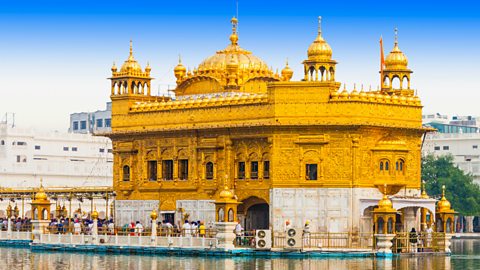Pilgrimage
Features and purpose of pilgrimage in Sikhism
A pilgrimage is a journey that has religious or spiritual significance, usually to an important religious place. Pilgrimage is not compulsory for Sikhs, and some Sikhs choose not to visit religious sites. Some Sikhs believe that the money spent on pilgrimage could be used as part of Vand Chhako (Vand Chakna)The sharing of what somebody earns or the fruits of their labour, generosity; the giving of charity. It is one of the three main pillars of the teachings of Guru Nanak. or sewaSelfless service to the community. to help others.
Someone may go to Ganges, Godavari, Kumbha festival, or bathe at Kaydaar Naatāh, or make donations of thousands of cows at Gomti; he may make millions of pilgrimages to sacred shrines, or freeze his body in the Himalayas; still, none of these is equal to the worship of God.
However, for some Sikhs, going on a pilgrimage is important. When they go on a pilgrimage, Sikhs often visit important sites in India and the PunjabPunjab meaning , where it is believed that Sikhism began.
Some Sikhs believe there are various benefits of pilgrimage:
- It strengthens Sikhsā faith.
- It allows time to be dedicated to spiritual reflection.
- It enables Sikhs to learn more about the history of Sikhism and the GuruCan mean God, teacher or guide. Usually means a teacher of religion. In Sikhism, it also refers to the ten human messengers of God. lives.
- It helps Sikhs to better understand the principles of Sikhism.
The spiritual wisdom given by the Guru is the True sacred shrine of pilgrimage.
Amritsar ā the spiritual centre of Sikhism
AmritsarA city in Punjab. Central to Sikhism. is a city in the Punjab. It is the centre of Sikhism and is where the Harmander Sahib, also called the Golden Temple in AmritsarCity in North-Western part of Indian. Spiritual centre for Sikhs., can be found.
Amritsar was founded by Guru Ram DasGuru Ram Das was the fourth of the ten Sikh Gurus, who lived from 1534 to 1581 and was given the title Guru on 30 August 1574. in AD1577. He ordered a sacred pool or lake to be dug. This is called the Amrita Saras (āPool of Nectarā) and it is from this pool that the city gets its name. The Harmander Sahib was built in the centre of the lake and completed in AD1604 by Guru ArjanGuru Arjan was the fifth Sikh Guru. He was born in 1563 and was executed in 1606 on the orders of the Mughal Emperor Jahangir, and was the first Guru to be martyred. .
Harmander Sahib ā the Golden Temple
Many Sikhs make a pilgrimage to the Harmander Sahib. āHarmanderā means āthe temple of Godā and āSahibā is a sign of respect. This is the most famous place of worship for Sikhs.

The Harmander Sahib is surrounded by a pool of clear water. This pool is sacred to Sikhs. The sacred water is believed to have healing powers. The temple is built on the level of the water, which people cross via a causeway. This shows that everyone comes to God as equals. However, worshippers have to step down into the temple, which is seen as a symbol of humility before God.
The temple has doors on each side, to show that people can come to God from all corners of the Earth. Inside the temple is the original Adi GranthThe first collection of Sikh writings, compiled by Guru Arjan. It can also refer to the Guru Granth Sahib. ā the first version of the Guru Granth SahibThe Guru Granth Sahib is the most important Sikh holy book. It is a collection of songs, prayers and hymns from the Sikh Gurus and other holy men, as well as teachings from other faiths. It is treated as a living Guru., which was compiled by Guru Arjan. A continuous reading of the Guru Granth Sahib is performed at the Golden Temple each day. The templeās langarThe kitchen and place where food is eaten in a Sikh Gurdwara. Often volunteers provide and cook food that is served to all as an act of sewa (charity). serves around 50,000 people from all over the world every day.